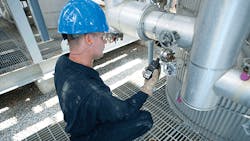Gas monitors are life-saving devices. To ensure that these vital instruments function properly, the two most important periodic maintenance activities are functional testing (also known as bump testing) and calibration.
A bump test subjects the monitor to a measured quantity of gas and verifies that the monitor's alarm sounds in a timely fashion. Calibration ensures the continuing accuracy of the gas monitor.
To ensure that the monitors detect and alarm as they should, manufacturers of gas monitors carefully design and manufacture monitors to the highest quality. Nevertheless, gas monitors are electrical devices and, as such, can fail unexpectedly. Two approaches minimize the impact of an unexpected failure: frequent bump tests and redundancy.
Bump Tests
Frequent bump tests minimize the interval during which a gas-monitor failure goes undetected. With this in mind, manufacturers have designed a range of bump/calibration accessories to make it relatively easy and cost-effective to perform bump tests. In addition, industry has tried to educate users on the proper operation and maintenance of gas monitors, including the performance of bump tests and calibration.
Despite this, a recent study of more than 25,000 monitors in the United States found that only 20 percent of users bump tested their instruments prior to each day's use. The average frequency at which a user bump tested/calibrated their monitor in the field was one month. In other words, the average user of a gas monitor could go a whole month before detecting an unexpected failure of the monitor.
Fortunately, gas monitors don't fail often. But the likelihood of failure is not zero, regardless of the brand of gas monitor. Surely most would agree that a month is a long time to go without knowing.
Why, then, do users not bump test more frequently? As is the case with most safety practices, education and training are essential to ensure ongoing safety.
That said, in practice, the cost and logistical challenges of bump testing are significant barriers to complying with frequent bump testing. In many applications, users work remotely in environments that make it challenging to conduct frequent bump testing. Also, the remote location of the workers makes it difficult for their supervisors to monitor that these tests are being performed as prescribed. In other applications, particularly where large gas-monitor fleets are involved, it's a logistical challenge to ensure that all monitors are bump tested at the start of each day.
Sensor Redundancy
While calibration/docking stations have helped to automate and simplify this process, it comes at a cost. This is particularly true in the case of single-gas monitors in large fleets, where docking stations add significantly to the overall cost of ownership.
Sensor redundancy enables a system to cope with single and multiple failures while retaining critical functionality such as detection and alarming when exposed to hazardous gas. While all components in a monitor gain from redundancy, the gas sensors in the monitor gain the most, in practice.
Still, there are two challenges with gas sensors. First, empirical evidence shows that of all the components in a gas monitor, sensors are the most likely to fail. This is true for virtually all the sensors incorporated into gas monitors and used in the field today. The vast majority of these are simple electro-chemical sensors that are used to detect H2S, CO, O2, etc., or catalytic-bead sensors for explosive gas detection. These sensors have been around for a number of years and are well-understood.
Their primary appeal is that they're simple, cheap and reasonably reliable. However, they're not fail-proof. While newer sensors with cutting-edge technology someday might displace these workhorses, redundancy is a smart way to ensure that gas monitors can properly sense gas at all times, at least in the interim.
Secondly, while electrical components can be tested for proper function through automated diagnostics that can be performed in the background without user intervention, sensors require a measured quantity of gas to be available. This only adds to the challenges of bump testing from cost and logistics standpoints.
Redundancy in sensors enables a gas monitor to detect a sensor failure and alert the user to take immediate action. In gas monitors without redundancy, the user has to wait until the next bump test is conducted to verify that the monitor is functioning properly. Based on the field data presented above, for the average user, this means waiting half a month. Can you go that long without knowing that you're safe?
In conclusion, bump testing is the only certain way of knowing that your gas monitor is functioning properly. Further, redundancy of sensors greatly reduces the likelihood of a malfunctioning monitoring between bump tests. As you can see, when it comes to safety, it pays to be redundant.
Raghu Arunachalam is the global director of multi-gas solutions and emerging technologies at Industrial Scientific Corp. He can be reached at [email protected].
